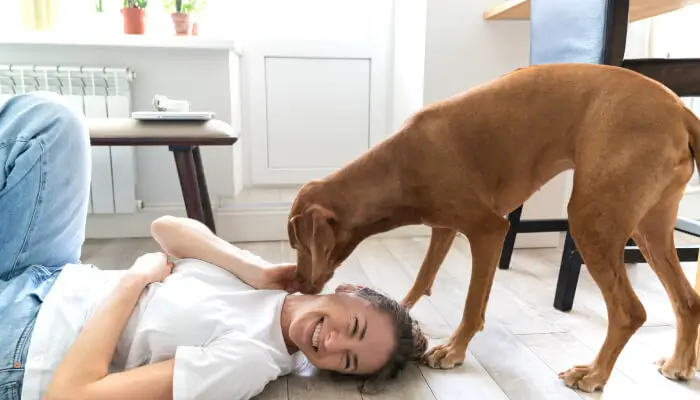There’s nothing worse than seeing your Vizsla limping around the house. Why is my Vizsla limping? Does your dog limp? Why do dogs limp? These are all questions that pet owners often ask themselves after noticing this concerning behavior in their four-legged friend. Fortunately, we’re here to answer these questions and provide you with some possible reasons why your beloved pup might be walking awkwardly.
The most common reasons for limping in Vizsla are injuries, panosteitis, osteodystrophy, osteochondritis, and rupture of the ligament. Similarly, some diseases like arthritis, cancer, kneecap dislocation, Dysplasia, and neurological disorders can also cause limping in dogs.
Read on to know about each of them in detail.
What Is Limping? Why Do Dogs Sometimes Drag One of Their Legs When They Walk?
Limping is a form of walking with an abnormal gate or gait. Typically, the dog will put more weight on one leg and often drags its toes as well. And this can be due to various reasons that include pain in the leg joints or paw pads; sore muscles and ligaments that make it difficult for a dog with arthritis to bear weight on his legs; nerve damage caused by an injury.
Why Is My Vizsla Limping?
Vizslas are energetic and agile dogs. So, limping is common in these dog breeds. However, there may be various reasons for the crawling of your Vizslas. And some of them are:
Vizsla Might Be Limping Due To Injuries
It is not uncommon for Vizslas to limp due to injuries, but it does not always mean that the dog’s injury is serious. Moreover, some of the injuries that lead to crawling in Vizsla are Sprains, Bruises, and Pulled muscles or tendons.
Your Vizsla might forget to put its foot down after jumping up onto furniture. As a result, the dog will end up pulling their back leg as they land on the floor because of a lack of support from one side. And this would lead to limping.
Panosteitis Causes Limping In Vizsla
Panosteitis is famous for growing pains. It’s a condition that puppies are susceptible to, and it usually resolves on its own when they grow up. But occasionally, panosteitis can linger for years, much like arthritis in humans.
Symptoms include reluctance to walk (especially after waking from sleep or after exercise), Painful chewing of any joint, and bone pain in one or more legs. Thus, Vizslas suffering from panosteitis often have difficulty getting around and start limping.
Hypertrophic Osteodystrophy
Hypertrophic Osteodystrophy is a condition that occurs when cartilage on the end of bones, called growth plates, inflame. This condition typically affects puppies who are two to six months old and may cause them to stumble or have difficulty walking.
Therefore, it is essential to be careful about your pet’s diet and exercise while breeding puppies. The symptoms of the disease condition include:
- Fever
- Swollen joints
- Lethargy (Decrease in activity level)
- Weight loss
- Immobility
Osteochondritis dissecans
Osteochondritis dissecans is a condition in which the cartilage and underlying bone fragments from the joint. And this can result in lameness, instability of joints (which may lead to arthritis), altered gait, or other symptoms.
The severity of these problems varies with how much damage has been to a particular joint’s articular surface: The more severe the injury, the symptoms are likely to be.
The cause of osteochondritis dissecans is unknown. It may result from repetitive trauma, or it can occur spontaneously in a joint that has to do many activities (i.e., no traumatic event). And it affects only some breeds like Vizslas, Rottweilers, and Bernese mountain dogs.
Vizsla Might Be Limping Due To Elbow Dysplasia
Elbow dysplasia is a condition that affects the elbow joint along with the surrounding ligament, bone, or cartilage. Vizslas are some of the few dog breeds that predispose this issue. These dogs suffer from this problem due to their body shape, which puts undue pressure on the elbows when they walk.
The symptoms of this condition include lameness or limping in the front limbs and a reluctance to move or exercise. There may also be pain, swelling, heat, loss of function, excessive licking at the elbow joint area, and hair loss around it.
Hip Dysplasia
Hip Dysplasia is a condition that causes the ball and socket joints of your Vizslas hips to become deformed. It will result in pain, inflammation, arthritis, and eventually limping as they age. In some cases, an x-ray or MRI scan can identify it. But a proper diagnosis requires specialist veterinary orthopedic examination and treatment for most dogs.
However, some dogs can show signs of pain or discomfort before developing full-blown hip dysplasia. Symptoms that your Vizsla may be suffering from Hip Dysplasia could include Limping, Difficulty getting up after resting for long periods, Difficulty walking and running, Soreness after exercise or prolonged periods of standing.
Vizsla Might Be Limping Due To Rupture Of Ligament
A ruptured ligament is one of the most common causes of limping in Vizslas, and it’s a painless injury. When any bone or joint sustains an impact force that exceeds its strength limit, it can tear the ligaments easily. It will also cause swelling around the injured area and excessive pain when moving that limb.
Kneecap Dislocation Causes Limping In Vizsla
Vizsla dogs are prone to kneecap dislocation. Why? Since Vizslas have bottomless chests, their leg muscles and ligaments work harder than most breeds of dogs. So, overstretching causes them to “buckle” at the knee joint. When this happens, the kneecap “falls out” of its normal position and rests on a bony ledge under the common.
If left untreated for too long, it can cause pneumonia or even damage the joint and cause pain during movement. As a result, Vizslas often have a “limping” gait, with one or both rear legs bearing most of their weight.
Arthritis
Arthritis is a condition where the joints of a dog start to deteriorate. The deterioration can be due to old age and injuries such as those that occur in car accidents. With arthritis, your dog’s joints will start to become swollen and noticeable. In addition, the more the dog walks, runs, or moves around, the worse their joint pain will get.
Vizsla Might Be Limping Due To Cancer
A Vizsla might be limping because he has bone cancer. Bone cancer in a Vizsla refers to the presence of new lumps under one or both joints. These lumps are present on the elbow, back thigh area, and shoulder joint, which will start to grow bigger as time progresses. The dog may also experience loss of appetite, weight loss, and fever.
Neurological Disorders
Neurological disorders put pressure on the nerves and damage the spinal cord of your Vizsla. The damage to the spinal cord can cause your Vizsla to walk awkwardly and may lead to paralysis.
Furthermore, your Vizsla loses the coordination between limbs and nerves. Generally, you can recognize neurological disorders in your Vizsla by the following three symptoms: paralysis of one or more limbs, an inability to walk with a straight back, and hind legs stay close while your dog stands. In addition, the neurological disorder might have other effects on your dog, such as incontinence, blindness, and dementia.
What Does It Mean If My Vizsla Is Limping But Not Crying?
Although, limping results in excessive pain and inability to walk in most cases. But still, there are few chances where your Vizsla might not cry and give signs of distress and still be limping, such as when it is running a lot, playing fetch, or getting a good scratch on the back.
Besides this, there is another meaning of limping without crying for your dog. When the Vizsla is limping, has swollen paw pads with abscesses, this could be due to an injury. However, it might have healed but caused some pain in your pet’s joint. Moreover, in cases like joint infection, Vizsla will limp and show signs of lethargy.
How Do I Know If My Vizslas Limp Is Serious?
Vizslas are not a breed that typically needs medical treatment, as they have very few genetic health problems. However, this may be different if your pup’s limp has been going on for over two weeks and seems to worsen after physical activity or is not responsive to rest alone.
If your Vizsla’s limp is severe enough, you should take him for health checkups. So, the indication that the limping of your Vizsla is serious are:
- Crawling has been going on for over two weeks.
- The limping is not responsive to rest alone.
- The limp becomes worse after physical activity.
- Vizsla is vocalizing with crawling.
- Suddenly, your dog has become aggressive.
- Your Vizsla doesn’t allow you to touch his limbs.
- Crawling is constant, steady, and doesn’t get better.
- Crawling means pain or discomfort of the dog.
What Should I Do If My Vizsla Is Limping?
If your Vizsla’s limp is not severe enough to warrant a vet visit, you should make sure they get proper rest and pain medication. Non-steroidal anti-inflammatory medicines like ibuprofen are for short-term relief of the symptoms.
Furthermore, other tips that can help you to manage limping in your Vizsla are as follows:
- Keep your Vizslas muscles limber and as strong as possible by giving them some light exercise. It can be anything from a quick walk around the block to playing fetch in the yard for five minutes, depending on their level of pain and activity tolerance.
- Try using ice packs or cold compresses after exercising or for mild inflammation throughout the day.
- Keep your Vizslas food and water dishes on a low shelf or bench to encourage them to drink more frequently, which can also help with joint pain.
- Reset their mind by playing fetch in the yard, taking short walks around the block, or going for a car ride if they are up for it.
The key to managing a limp in your Vizsla is prevention and patience. The good news about this condition is that most limps are not severe or long-term, so if you keep an eye out for the signs of inflammation, rest them when they need it, and give them some light exercise when possible, you can keep your Vizsla limping in no time.
Conclusion
Finally, it is essential to understand why is Vizsla limping? It can be hard to diagnose correctly without a physical examination.
This article provides an overview of the most common causes for limping in vizslas, and it also offers tips on how you should proceed if your dog starts crawling. Still, there are many other potential reasons why Vizsla is limping.
If your dog’s limping, the first step is to contact a veterinarian, who will be able to provide an accurate diagnosis and make appropriate recommendations for treatment.
Leave your queries in the comments so that we can resolve them in the future.



